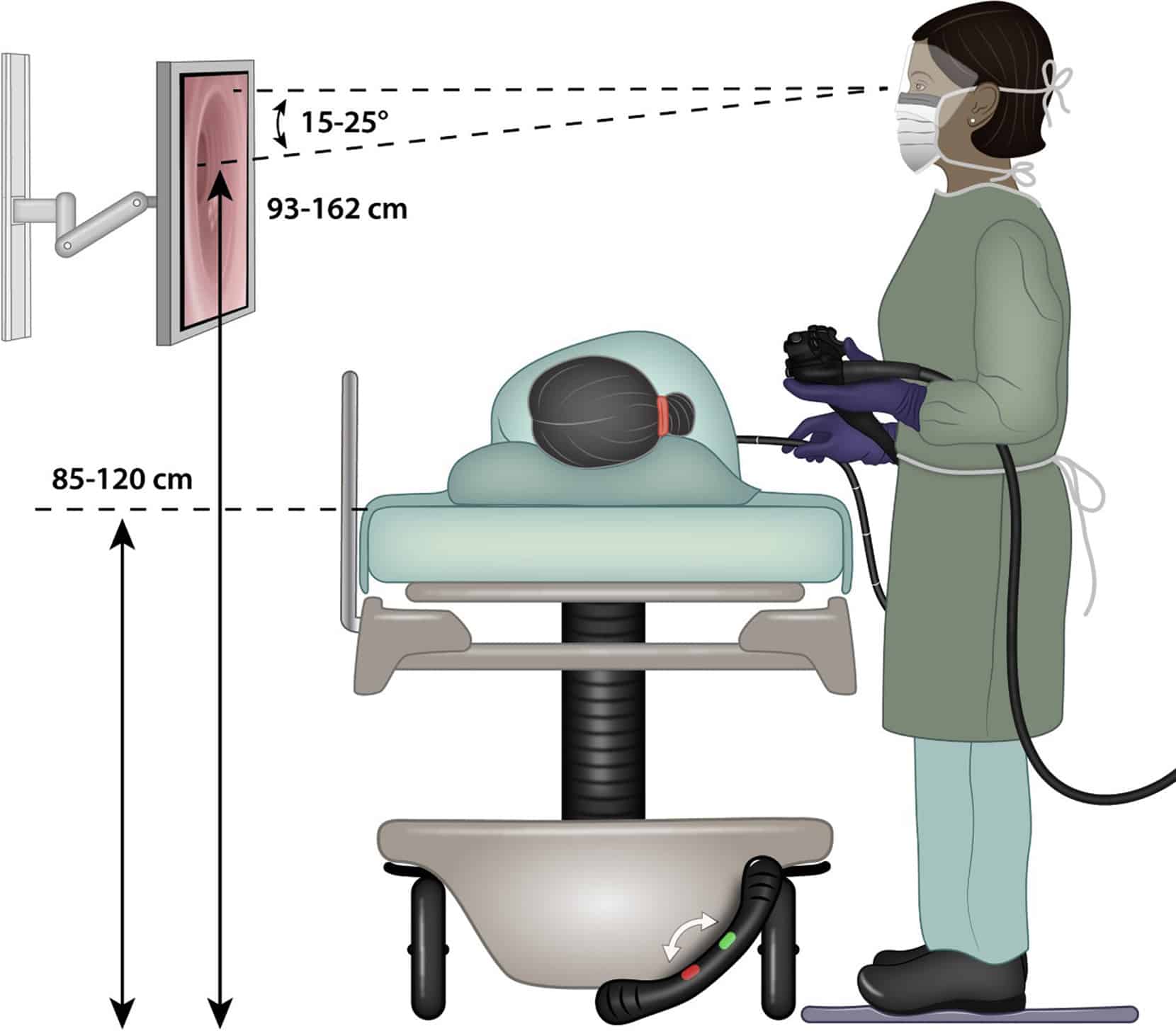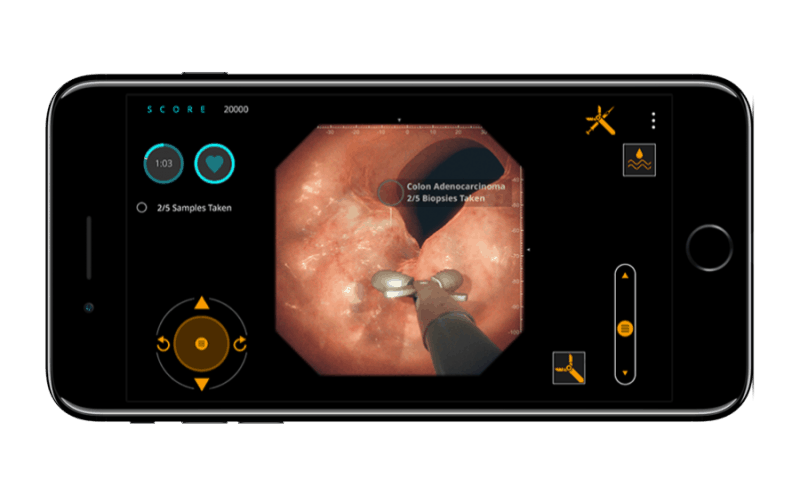Ergonomic Endoscopy – Are we there yet?
In recent and post years the topic of ergonomic endoscopy has been raised numerous times, and the question still stands – how do you perform endoscopy ergonomically?
Stepping into the New Year, we felt there was no time like the present to help figure out how to operate your endoscopic procedures ergonomically, to minimise injury and help reduce the inability to work or train.
All about ergonomics and endoscopy…
Endoscopy is a complex competence which requires educative training and practice to ensure the procedure is performed correctly. There is a large occurrence of reported endoscopy-related injuries – such as carpal tunnel syndrome (CTS), DeQuervain’s tenosynovitis, and lateral epicondylitis – while numerous studies have demonstrated high-risk biomechanical exposures during the performance of routine colonoscopy. The predominant focus of initial training is to ensure trainees have the skillset to technically complete the procedure, which combined with the learner’s eagerness can often mean little attention is given to the more cognitive elements of endoscopic practice, unfortunately resulting in areas of ergonomics being missed. As it states within the name, ergonomic endoscopy is a focus on comfort design to minimise the risk of injury and ensure superior procedural training is matched with equally outstanding ergonomic practices.
Most discussions surrounding endoscopy ergonomics are endoscopist focussed; relying on self-resolutions to minimise their injury. Our focus is to investigate and identify potential departmental-wide solutions, to help reduce the unfair reliance on self-solving solutions from physicians, in order to help consolidate effective widespread team solutions. – “As a profession, we need to collectively advocate for endoscopist safety.” – GIE.
Endoscopic Procedural Risks:
Various clinical studies report a 39% – 89% chance of potential work-related musculoskeletal disorders in endoscopists,1, 2, 3, 4, 5, 6,7, indicating a requirement to further investigate and understand the risk factors for endoscopy-related injury.
Identified exposure areas for work-related musculoskeletal injury are repetition, high forces, especially when combined with non-neutral postures, and the percentage of time the hand is engaged in high-risk pinching.8, 9, 10 . It has been demonstrated that high-risk exposures during routine colonoscopy occur,11, 12 .
Ergonomic Endoscopy Solutions:
A frequent question asked by endoscopists is, “What can I do…to prevent injury?”, not “What can collectively be done to prevent operational-risk during endoscopic practice?”
The discussion predominantly focuses on the modifiable elements of the endoscopy unit, such as monitor position and height, bed height, and neutralizing postures.
The ‘hierarchy of controls’ (fig 1) exemplifies Occupational Safety and Health Administration’s recommendation for managing and alleviating the risk of endoscopic occupational injury. In the illustration, endoscope operators are placed at the bottom of the effective exposure control hierarchy. Thus prioritising alternative risk-reducing methods, which are deemed more effective, such as ‘elimination’ and ‘substitution’ of hazards; embracing the concept of prevention through design.13

Endoscope design:
Many articles discussing endoscopy ergonomics have touched on endoscope design as a predominant focus, highlighting the importance of scope flexibility for the spectrum of potential users – instead of the current one-size-fits-all design. “When we think about the practice of endoscopy 40 years ago (in the 1980s, when flexible video-endoscopes were first introduced), it is remarkable how little has changed in basic endoscope mechanical design, despite enormous advances in optics.1”
“Striving for a short, straight, and soft scope orientation that is maximally responsive to tip deflection and torque will minimise the force required to perform diagnostic and therapeutic endoscopy.” 1
“However, the basic design of the endoscope remains unchanged. We would never think to drive a car whose seat or steering wheel could not be adjusted to our body dimensions, yet every day, we drive endoscopes that were not designed with the operator in mind.”1
Suggesting that ergonomic endoscopy can be achieved with the help of endoscope manufacturers re-designing scopes with flexibility to adapt to user requirements.
** Side note: “[Throughout the lifetime of an endoscope, the cables can become less responsive, therefore often resulting in additional force being required to accomplish the same degree of tip deflection. There is only one endoscope manufacturer that] recommends proactive endoscope maintenance after a [set] number of procedures. [Therefore, the concern is endoscopists may be working with suboptimal performing endoscopes – unless the endoscopes are under warranty or being leased.”1
Engineered Controls:
Following on from endoscope design, engineered controls – which isolate the hazard – follow as the next resolving method in injury prevention. These may pose as tools which optimise interaction with the endoscope, such as right/left assist dials, endoscope support stands, or endoscope caps.14 and optimise interaction within the procedural environment, such as adjustable monitors and beds that allow for neutral postures during the performance of endoscopy.
Administrative controls:
Further to the above collective solutions, the third most effective method for minimising endoscopic work-related injury is administrative controls; managing exposures through policies and workplace practices.
“[A clear] example of an administrative control is the endoscopy schedule. Back-to-back full days of endoscopy may not allow adequate time for rest or recovery. Ideally, schedules should ensure that [clinicians] have adequately recovered from the previous endoscopy session before they are scheduled for another day or half-day of endoscopy.”1
Within the collective of administrative policies, there should be inclusion of an ‘endoscopy ergonomics program’, which ensures ergonomic training for all endoscopy team members, while ensuring implementation of a ‘pre-procedure ergonomic time-out’.

1 © 2019 Amandeep Shergill
** pre-procedure ergonomic time-out – An ergonomic time-out before the performance of an endoscopy will ensure proper positioning and height of the monitor and bed. The monitor should be placed directly in front of the endoscopist so that the centre of the screen is at the resting eye position (15-25 degrees below the horizon). Monitors and beds should be adjustable so that the 5th percentile female up to the 95th percentile male can achieve neutral postures of the head, neck, back, shoulder, and elbow (ranges of required adjustability are annotated in the figure).1
PPE:
Finally, this may come as a surprise due to the current heavy reliance upon endoscopists to self-solve when attempting to mitigate work-related injuries, but “personal protective equipment” or endoscopist-driven interventions to control exposure15 has been deemed to be the least effective method for reducing work-related injury, in the illustrative ‘hierarchy of controls’ (fig 1).
Self-solving endoscopist-driven interventions to control risk exposure are essential but won’t be effective if used alone. A combination of self-resolutions, with the above collective control measures need to be implemented in tandem for departmental success in injury prevention, thus reduction.
It was also noted that although maintaining physical fitness and maximising strength and flexibility can be endorsed as part of a healthy lifestyle, they cannot be recommended as effective means to reduce endoscopy-related injury.1
Ergonomic endoscopy… So, what’s the verdict?
We’re in an era where the endoscope market is focussed on superb image clarity, meaning little time has been expended on user centric scope design, leading to a lack of ergonomically conclusive endoscopic scopes and devices.
The ever-increasing demand and high complexity of endoscopic procedures, coupled with the lack of tools designed to optimise interaction with the endoscope, poses a threat which may endanger the longevity of the endoscopic workforce.
In a time of increased procedural pressure, there are fundamental endoscopic ergonomic issues which need to be addressed. While endoscope design adaptations will be transitional, it is imperative that where appropriate, the ‘hierarchy of controls’ and basic ergonomic principles are implemented to collectively mitigate exposures, as much as possible.
Now, may be the time more than ever to further consider endoscopy ergonomics training for clinicians. Interesting parallels can be drawn and learnt from sport. – As highlighted in: ‘Ergonomics in endoscopy: Should the endoscopist be considered and trained like an athlete?’16
Related Articles:
- Ergonomics in Endoscopy: Balancing Efficiency and Physician Wellbeing
- Optimizing ergonomics during endoscopy
- Video of the Week: Ergonomics of Endoscopy, with Patrick E. Young, MD, FACG, and Manish B. Singla, MD
- Protecting the Endoscopist: Ergonomics — Amandeep Shergill | UCLA Digestive Diseases (Below)
Sources:
[2] – Battevi, N., Menoni, O., Cosentino, F. et al. Digestive endoscopy and risk of upper limb biomechanical overload. Med Lav. 2009; 100: 171–177
[3] – Kuwabara, T., Urabe, Y., Hiyama, T. et al. Prevalence and impact of musculoskeletal pain in Japanese gastrointestinal endoscopists: a controlled study. World J Gastroenterol. 2011; 17: 1488–1493
[4] – Hansel, S.L., Crowell, M.D., Pardi, D.S. et al. Prevalence and impact of musculoskeletal injury among endoscopists. J Clin Gastroenterol. 2009; 43: 399–404
[5] – Byun, Y.-H., Lee, J.-H., Park, M.-K. et al. Procedure-related musculoskeletal symptoms in gastrointestinal endoscopists in Korea. World J Gastroenterol. 2008; 14: 4359–4364
[13] – The National Institute for Occupational Safety and Injury (NIOSH). Prevention through design.
[16] – Ergonomics in endoscopy: Should the endoscopist be considered and trained like an athlete?



